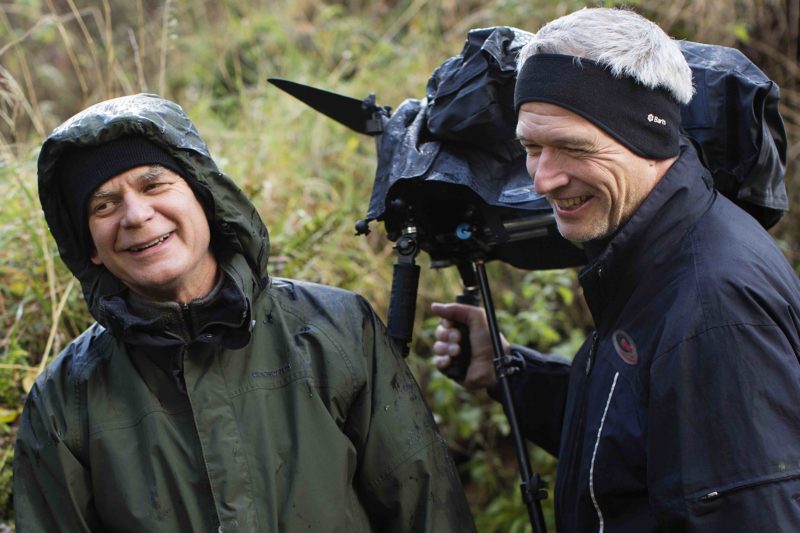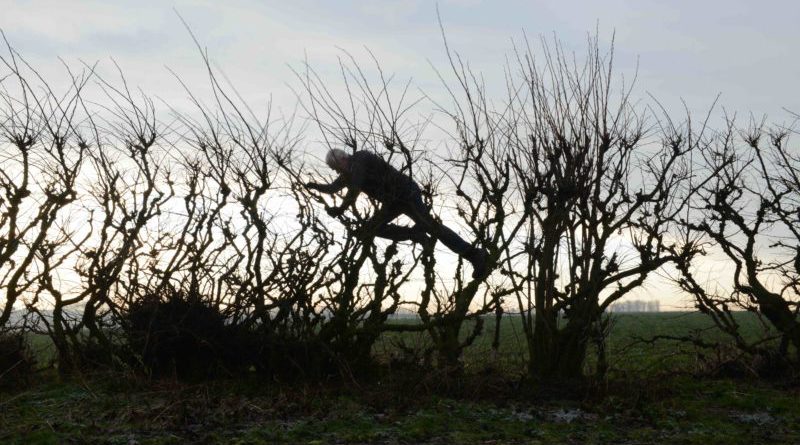INTERVIEW: Artist Andy Goldsworthy leans into the wind
Photo: Andy Goldsworthy works on a new piece of art in Leaning Into the Wind, a Magnolia Pictures release. Photo courtesy of Magnolia Pictures. Photo credit: © Thomas Riedelsheimer, all rights reserved. Provided by Film Forum press site / Magnolia Pictures press site with permission.
Andy Goldsworthy gets his hands dirty.
The artist is world renowned for working in unique mediums and creating startlingly beautiful compositions that navigate the intricacies of the natural world. Whether it’s a stone wall snaking its way around a grouping of trees at Storm King Arts Center in the Hudson Valley of New York or artfully arranged leaves creating a blackhole effect in the woods, Goldsworthy’s output is extensive, celebrated and sometimes transitory.
Goldsworthy’s art-making was captured by filmmaker Thomas Riedelsheimer in the acclaimed documentary Rivers and Tides, and the two pair up again for their new cinematic project, Leaning Into the Wind, now playing at New York City’s Film Forum.
“Well, I suppose in the making of Rivers and Tides, Thomas and I had got quite close, so we would keep in contact,” Goldsworthy said in a recent phone interview. “I think that there’s sort of an inevitability about it. I mean, we’ve both had to live with Rivers and Tides. That’s not so bad. It’s a great film, but it’s such a well-received film. And many people saw it, but at the end of the day, it was just an hour-and-40-minute view of the work at that time through Thomas’ lens.”
Goldsworthy said his working relationship with Riedelsheimer was close knit and intimate. Leaning Into the Wind did not feature a large production staff. It was mostly the filmmaker, the artist and the artist’s assistant (Holly, Goldsworthy’s daughter). That allowed everyone involved to concentrate on the art.
“When I’m working, I’m totally concentrating on the work,” he said. “The thing is with Thomas, he’s totally concentrated, too, so we share this concentration. It’s an interesting dialogue in a way.”
When he was being filmed, Goldsworthy never thought about the end product and the audience. He simply thought about the film as a means of documentation.
“It’s always a surprise to me when it’s out there; that’s the uncomfortable bit in a way,” he admitted. “I don’t think of it in terms of audience. I just enjoy that creative thing that happens between two people when they’re working on something, and the dialogue that occurs with that and the documentation of it on film. Up until recently, I’ve done most of my own documentation on still photography, so it was quite nice to get back something that shows the work in the round, so to speak. … As it being out there in the public, I think I see it in the same way as I make a book or an exhibition. I think about the work rather than the public in that respect. That’s not entirely true because sometimes the works are made and need that kind of engagement with people, the human experience, not as an audience, just as a participant. And when it’s a theater, it’s very much an audience, so I guess I don’t feel it in the same way.”

Goldsworthy’s art sometimes defies categorization. In the new film, for example, he works with live sheep as a medium. Other times, the current in a babbling creek will inspire his imagination. One of his most popular works involves what appears to be a neon, nuclear glow at the root system of a large tree. Whatever the final output might be, it’s usually different than the original idea. That’s one of the beauties and wonders of working in nature and getting one’s hands dirty.
“That’s the interesting thing about making work, about real life,” Goldsworthy said. “It’s the fact that you take this idea out there … and then you see this thing. And you engage with the landscape. You start reading the landscape. You understand the landscape, and then the material starts changing what you’re doing. That’s the lifeblood of the work. I love that.”
On occasion, he will also return to a work to see how nature has transformed his art. Take, for example, his stone wall at Storm King.
“I think there are works like Storm King that I obviously return to, to see how it is getting on, but the ones that I love to reach out are those works that have been made to a large extent for the future,” he said. “I’m an artist who works with time, and the past is really important — every part of material I work with, how it got there, how it grew. And then there is the moment, the day, when I’m making it, and that’s sort of important. But really the future has to be dealt with, too, and I’m not saying future as in terms of me wanting to be known for posterity. It’s more about it’s interesting what will happen to the thing, trying to project what will occur, so Storm King, the changes that occurred to that are really around it, the way people engage with it, the problems with the erosion, the trees falling. So it’s a sort of maintenance, and when I say maintenance, it is kind of a nourishment. … Works like the ‘Garden of Stones’ in the Museum of Jewish Heritage, which trees are growing out of the stone, the work is unfinished for many, many years. Those are the works I love to go back to, to see how they changed.”
Riedelsheimer’s new film also explores what may be Goldsworthy’s most unique medium: live sheep. However, this shouldn’t come as a surprise given that the artist lives near the Scottish Highlands, a place where sheep are part of the landscape.
“The sheep are interesting,” Goldsworthy said with a laugh. “We’re surrounded by sheep, and the hills have been shaped by the sheep. There are no trees there [in Scotland] because of the sheep, so they have a very powerful impact on the landscape. And yet most people’s perception of sheep are of them being as wooly, cute animals, pastoral, and I think that misreading of the sheep to me is sort of indicative sometimes of how we misread the landscape generally, that nature is this wonderful, therapeutic backdrop for us to go to, to relax and enjoy ourselves and regain our energy. Well, for me, it’s not that. For me, it’s a place of intense challenges and difficulty and great duty, so the sheep as a subject is interesting. The sheep were responsible for great social upheavals — the Highland Clearances, the Enclosure Act in Britain. They had people evicted from the land and were replaced by sheep, so they’ve had this enormous impact and continue to have this enormous impact on the land.”
Fans of Goldsworthy’s work know that the artist loves to explore the forces that shape the land, so the sheep are merely an extension of his lifelong love for understanding how and why the surroundings perpetually change.
By John Soltes / Publisher / John@HollywoodSoapbox.com
Leaning Into the Wind, directed by Thomas Riedelsheimer and featuring Andy Goldsworthy, is now playing at New York City’s Film Forum. Click here for more information.

